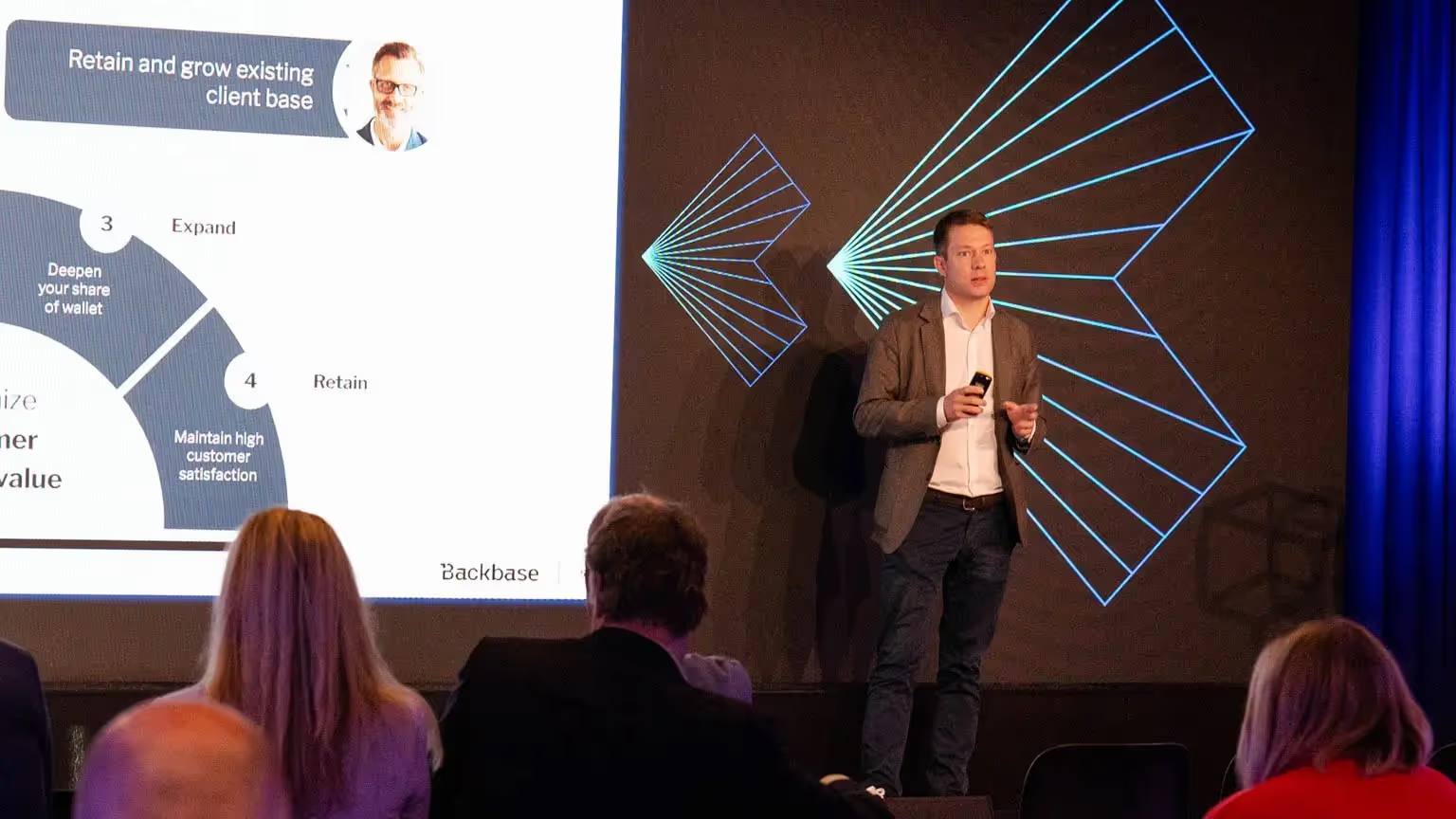At Backbase ENGAGE Europe 2025, a panel of wealth management leaders gathered to tackle one of the industry's most pressing questions: How do you harness AI and automation to scale operations without losing the human relationships at the heart of high-touch, white glove service?
The conversation brought together perspectives from across the wealth management spectrum. Mindaugas Vaiciulis, SVP and Head of Technology for Wealth Planning & Investments at Danske Bank, shared insights on serving everyone from retail customers to ultra-high-net-worth individuals across the Nordics. Henning Soller, Partner at McKinsey, provided an industry-wide view on technological transformation. Divakar Padmanathan, Senior Partner and Head of Client & Digital Asset & Wealth Management at Alpha FMC, brought data from benchmarking 100,000 end clients. And Toby Cross, who leads client support for Rothschild & Co Wealth Management, offered the ultra-high-net-worth perspective where client experience is paramount.
The answer that emerged looked deeper than just digital vs personal. It focused on using technology to make advisor relationships more valuable than ever.
The patience problem - clients won't wait anymore
Cross opened with an observation about changing client expectations. Before iPads, waiting 60-90 seconds for a computer to start was acceptable. Today, if a screen doesn't blink to life instantly, frustration sets in.
"I think the clients of tomorrow will be intolerant of delay," Cross explained. "The execution, however, certainly for our clients, is more of a luxury experience and a service experience than it is about the component parts."
The core client needs haven't changed in 500 years - wealth preservation, growth in good years, protection in down years, and institutional safety. What's changed is tolerance for poor experiences or waiting. The threshold for exceptional service keeps rising because clients can access sophisticated tools themselves.
"The game still needs to be up because the threshold of what we provide still needs to be an order of magnitude higher than our clients can go and access for themselves," Cross said.
For ultra-high-net-worth wealth management, the question isn't whether technology will replace advisors. It's how to stay ahead when digital tools make competitors better.
AI as relationship enhancer, not replacement
The panel consensus: AI won't replace advisors in wealth management. It will make them more present, more prepared, and more valuable.
Vaiciulis described how AI can handle the barriers that prevent advisors from being fully present with clients. Meeting transcription, for example, creates interesting tensions. On one hand, having an AI agent transcribe conversations feels like adding a third party to an intimate discussion. On the other hand, it frees advisors to be completely engaged instead of taking notes.
"That gives an opportunity for the adviser to be even more present with you, fully with you, talking instead of taking notes, of trying to remember different things, and then, of course, not spending two hours after trying to type it down and send it over to you," Vaiciulis explained.
But implementation requires careful thought. Cross revealed that Rothschild & Co spends significant time considering where voice transcription works and where it doesn't. For some clients, efficiency matters. For others, having a bot invited to their meeting feels wrong.
"We want to give the choice to clients as to how they wish to interface with us," Cross said. "The digital domain that we're moving into, in theory, means that we can tailor the experience much more to the needs of individual clients, but it just requires a huge amount of thought and consideration from the lens of the client."
The key insight: Technology must serve the relationship, not dictate it.
Scaling wealth management to everyone
While ultra-high-net-worth clients get bespoke advisory services, most bank customers can't access personalized wealth guidance. AI changes that economics.
Vaiciulis described Danske Bank's ambition to provide wealth management experiences across all customer segments, from standard retail to ultra-high-net-worth. For retail customers in the wealthy Nordics region, AI can deliver 90% of what a wealth advisor provides - goal setting, guidance, education, and recommendations.
"AI agents can almost completely take over 90% of that experience, and a lot of customers will actually even end up making decisions on how they want their next action to be," Vaiciulis said. "Do I want to start investing? Do I need to do something with the property I own?"
The vision isn't two separate experiences - self-service digital and in-person advisory. It's a seamless conversation that shifts between AI-powered guidance and human expertise as complexity increases.
"The true hybrid is going to be very, very different where all of the journeys and experience is a seamless single conversation-like experience ultimately that technology will enable us to also give to retail customers," Vaiciulis explained.
AI makes wealth management accessible at scale while preserving the relationship-driven model that defines the industry.
The efficiency paradox - freeing advisors to serve more clients
Cross posed a critical question to his organization: Can you use AI to eliminate the worst 10% of your job?
It's a different approach than typical cost-cutting. Instead of COOs announcing headcount reductions and asking which roles require the most people, Cross challenges employees to identify non-client-value-added tasks and use technology to eliminate them.
"If people can use the technology that is available to solve their own problems, they're most motivated to do it properly. They're closest to the problems that they have," Cross said. "And once they've eliminated 10% of the things that they don't like doing, they're considerably less likely to go and work for a competitor."
The result isn't just efficiency. It's retention. When advisors spend less time on administrative work and more time with clients, job satisfaction increases and client relationships deepen.
Rothschild & Co deployed Microsoft Copilot throughout the organization. Every employee has access to AI tools tailored to their permissions. The goal: let people eliminate the tasks that drain energy so they can focus on work that creates client value.
This contributes to competitive advantage. Unlike some firms where clients get different advisors every few years, clients at firms like Rothschild & Co maintain relationships with the same person for decades. "That's a genuine moat from a competitive advantage perspective," Cross noted.
The training gap - treating AI like Excel
Cross highlighted a big inconsistency. Wealth management firms hire analysts and immediately send them to eight-week Excel boot camps followed by PowerPoint training. Yet they deploy AI tools - potentially the biggest force multiplier for personal efficiency - without any training.
"I have witnessed people struggle," Cross said about Copilot adoption. "And I shouldn't be surprised about them struggling because it is effectively a new tool that nobody has any real experience in, yet we've done no training."
The analogy was vivid: Firms gave employees "the most advanced wood that anybody has ever had in a golf bag" but nobody showed them how to swing it. Those who figure it out will "suddenly be hitting the ball 800 yards" while others struggle.
The solution: Treat AI tools like any other business-critical skill. Acknowledge there's a new icon in the system tray - whether it's Microsoft Copilot, enterprise ChatGPT, or Gemini. Teach people the perimeter, the power, and how to use it. Make it as fundamental as Excel or PowerPoint.
"It stops being scary or it stops being something that can be ignored," Cross explained. "And then people with problems within the company, ideally, who look after clients, can use yet another tool to solve those problems."
The adoption challenge - keeping teams engaged and unafraid
Vaiciulis identified two critical challenges in AI adoption that transcend wealth management.
First, keeping people engaged through the early awkward stages. A year ago, when teams started experimenting with AI, many dismissed the output as "crap" or "nonsense." Those who persisted now see results that are exponentially better. But organizations must help teams push through the frustration of imperfect early results.
"How do you keep them engaged and picture that, look, it's only gonna get better?" Vaiciulis asked. "I think a lot of people who did not give up last year, this year, they're like, okay. Yes. We can now see that."
Second, preventing fear from paralyzing employees. Some worry they're already behind because they didn't start a year ago. Others fear AI will make them redundant. This fear leads to self-sabotage - waiting a little longer, staying off the boat.
"As an organization, not only that you need to keep people engaged and give them time to experiment and try things out with the thought that it's only gonna get better," Vaiciulis said. "And then the second thing is remove that obstacle of being afraid."
The narrative matters. Yes, those who don't adopt AI tools may lose out long-term. But it's more powerful to show people how AI eliminates tasks they hate doing rather than threatening their relevance.
"There's so many things that you don't actually want to do that you will be able to get rid of instead of thinking that, okay, if I don't do it, then I'm kind of redundant," Vaiciulis explained.
The first-principles problem - nobody's done this before
Cross raised an observation about why AI adoption feels different from other technology shifts. For the first time in his career, people must think from first principles because nobody has experience doing this well at another firm.
Typically, new hires bring accumulated experience from watching things go wrong elsewhere. Consultants provide value because they've seen implementations across many firms. But with AI, there are only a small number of people with extraordinary vision about where it's going. Everyone else is "caught in this wave of not quite understanding it."
The surfing metaphor landed: Get caught in the wave wrong, and you get "turned upside down and washed around, and you've no idea which way is up."
Cross recommended Ethan Mollick's book "Co-Intelligence" as a practical guide through the hype. "It helped me make sense of all of the hype that was adjacent. And there is way more hype than there is genuine academic commentary on this topic."
The reality: AI transformation in wealth management is genuinely new. Firms are learning by doing, not by copying best practices.
Three steps to get started
The consultants closed with practical advice for wealth management firms starting their AI journey.
Soller's framework: Set up a program with business (not just IT), rethink change management to bring people along, and only then think about technological implementation - after ensuring data hygiene.
Padmanathan emphasized prioritization: "Being crystal clear on the genuine business value of all the things that you can do and how technically hard it's going to be to do that and to be laser focused on those things when you're prioritizing what to go after."
The strategy: Focus on high-value, low-complexity use cases first. Quick wins create advocates. Advocates drive adoption. Adoption becomes self-sustaining when people see AI solving real problems in their daily work.
What this means for wealth management
The wealth management industry faces a paradox. Clients expect digital sophistication and human relationships. Firms need to scale advisory services while preserving personalization. Advisors must adopt AI without losing what makes them valuable.
The panel showed these aren't contradictions. Digital tools that free advisors from administrative work let them be more present with clients. AI that handles routine guidance scales wealth management to customers who couldn't access it before. Training that demystifies AI tools turns fear into adoption.
Trust remains wealth management's currency. Technology won’t erode it - technology can help scale it.
The firms winning in five years will be those who used digital to make personal relationships more valuable than ever.
About Backbase ENGAGE Europe 2025
Backbase ENGAGE Europe brought together hundreds of banking executives, technology leaders, and industry experts in London to explore how unified platforms and AI are unlocking Growth Mode for financial institutions. The two-day event featured keynotes, customer stories, and panel discussions on AI transformation, platform modernization, and the future of digital banking.
.webp)





